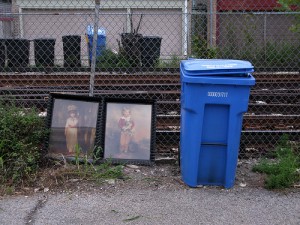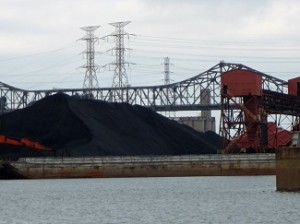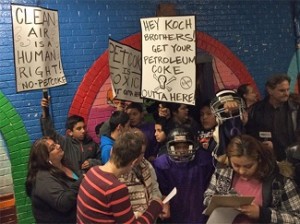Last Thursday the Illinois EPA held a contentious public meeting on Chicago’s SE Side to hear residents’ concerns and complaints about the massive piles of petcoke — a waste by-product of tar sands oil refining done in nearby Whiting, IN — being accumulated along the industrialized banks of the Calumet River, in close proximity to the East Side and Deering neighborhoods of Chicago.
As reported here last Friday, 15 Nov 2013, by Progress Illinois:
A Chicago community meeting the Illinois Environmental Protection Agency (IEPA) hosted to discuss a proposed construction permit for KCBX Terminals Company quickly escalated into angry shouting from Southeast Side residents fed up with the firm storing large piles of petroleum coke, or petcoke, near their homes.
KCBX, which is controlled by the conservative billionaire brothers Charles and David Koch, stockpiles the petcoke, a byproduct of oil refining, along the Calumet River on Chicago’s far Southeast side. The thick, powdery petcoke is sent to KCBX from a BP refinery in Whiting, Indiana. East Side and South Deering residents have been sounding the alarm for some time now that petcoke dust is blowing into their neighborhoods and getting into their homes.
“No one asked us if we wanted to have these piles dumped in the first place. They just did it,” Southeast Side resident Sue Garza told the IEPA officials at the packed two-hour meeting, held at the East Side United Methodist Church. “We have been the toxic dumping ground here for over 100 years. We don’t want it anymore.”
Brad Frost with IEPA’s office of community relations said KCBX is seeking a revised construction permit from the agency in order to bring new equipment, including 10 portable conveyors, a stacking conveyor and a portable hopper, to its site at 10730 S. Burley Ave. According to Frost, the company is not looking to increase its input or emissions.
“They can’t handle their [petcoke] dust now,” resident Guillermo Rodriguez fired back. “How is it not going to increase?”
Residents grew frustrated with IEPA officials, pointing out that the community is against the company’s activities and noted that issuing such a permit would allow for its site expansion.
“It is very simple,” said community member Martin Morales. “We don’t like it. We don’t want it. (Petcoke pollution is) making us sick. What else do you need?”
One person later shouted, “Move the piles! Who cares about the conveyors?” Another said, “If you’re the protection agency, protect us!”
“How many people have to get sick before you do something,” asked resident Ken Keefer. “Is there a certain number that have to come down with asthma or cancer before you do something? This has been going on for two, three years. And this is the first time you guys have shown up.”
Frost said the IEPA would take into account the comments made at the meeting, but noted that the IEPA has received very few formal, written complaints about specific issues involving the site.
One man fired back, “We can’t even open our windows because of the soot.” Later, the audience began to chant, “Move the piles!”
“Answer the question. When are you going to move the piles,” a gentleman asked the officials, which promoted another person to exclaim, “When we’re all dead!”
“Obviously there a lot of people here concerned about the facility,” Frost stressed. “We need to see [formal] complaints. That’s one thing we use to determine whether there are problems at sites.”
Frost did make a point, however, to stress that even though the agency has received few formal complaints, the IEPA is pursing enforcement against the company.
Earlier this month, Illinois Attorney General Lisa Madigan filed a lawsuit on behalf of IEPA against KCBX over alleged air pollution violations. In a statement, Madigan said the toxic mounds at KCBX’s storage site “are growing by the day without the appropriate protections to ensure nearby residents’ health and safety.”

Community members asked lawyers from the attorney general’s office, who attended the meeting, what else could be done to more quickly shut down the facilities and get rid of the petcoke mounds. The officials stressed that the current case is pending, and it has to go through a formal legal process.
Additionally, a group of Southeast Side families filed a lawsuit at the end of October against KCBX and a few other companies that store petcoke. The lawsuit came on the heels of notices of air pollution violations the IEPA recently issued to Beemsterboer Slag Co., which also stockpiles the coal-like waste product along the Calumet River.
BP is in the process of modernizing its Whiting refinery and plans to to boost the amount of petcoke it produces at the facility to 2.2 million tons of a year.
Tom Shepherd with the Southeast Environmental Task Force told the crowd that the current issues the community is experiencing is only “the tip of the iceberg.”
“There’s going to be at least three times more than is over there today,” he said. “Today we’re getting 700,000 tons a year, but once that coker goes online, it’s going to increase to 2 million tons a year. That’s 6,000 tons a day.”
“Imagine how many trucks, barges and trainloads are going to be coming through our neighborhood,” Shepherd continued. “If they’re getting a permit for 10 additional conveyors over there, that means that they’re going to increase ten-fold, but we heard three-fold. That’s scary enough.”
The audience really got peeved when they learned the IEPA has to make a decision regarding KCBX’s permit next week. IEPA officials wouldn’t say whether they would be extending the review period for the permit, approving the permit or denying it.
“You’re here a week before,” Rodriguez later asked. “Where were you when this all started, when this began? Where were you then? Who’s protecting our water source? They’re pumping water out of that lake and they’re spraying their piles. That runoff goes where? It goes into our streets. It goes into our drinking water. If you think this is a good idea, let’s put it in your backyard.”
Residents called on Ald. John Pope (10th), who attended the meeting, to speak, but then heckled and interrupted him. Pope made a point to stress that he has been working with elected officials at the local, state and federal levels to see what can else be done about the piles.
“As much as we all are passionate about the problems, there’s got to be a formal process, and it starts unfortunately with the complaints,” he added. “I know everyone’s complained in the past, but there’s got to be formal complaints lodged.”





